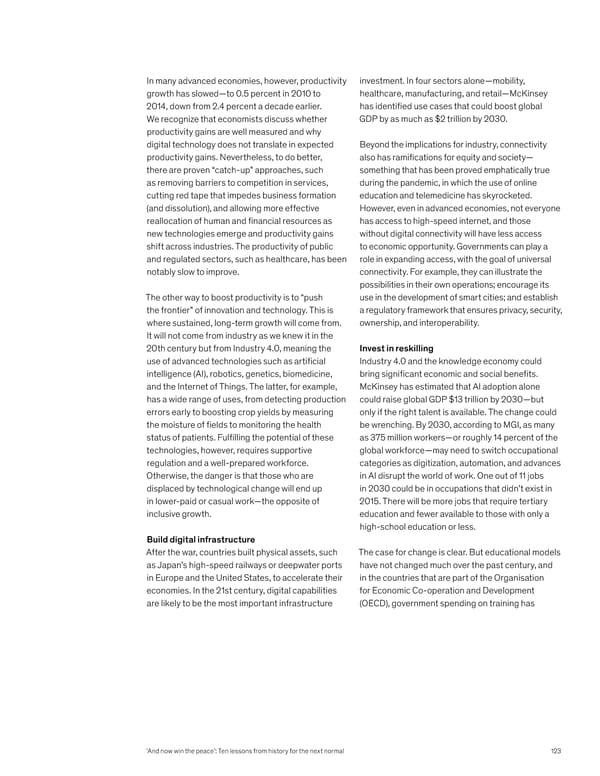In many advanced economies, however, productivity investment. In four sectors alone—mobility, growth has slowed—to 0.5 percent in 2010 to healthcare, manufacturing, and retail—McKinsey 2014, down from 2.4 percent a decade earlier. has identified use cases that could boost global We recognize that economists discuss whether GDP by as much as $2 trillion by 2030. productivity gains are well measured and why digital technology does not translate in expected Beyond the implications for industry, connectivity productivity gains. Nevertheless, to do better, also has ramifications for equity and society— there are proven “catch-up” approaches, such something that has been proved emphatically true as removing barriers to competition in services, during the pandemic, in which the use of online cutting red tape that impedes business formation education and telemedicine has skyrocketed. (and dissolution), and allowing more effective However, even in advanced economies, not everyone reallocation of human and financial resources as has access to high-speed internet, and those new technologies emerge and productivity gains without digital connectivity will have less access shift across industries. The productivity of public to economic opportunity. Governments can play a and regulated sectors, such as healthcare, has been role in expanding access, with the goal of universal notably slow to improve. connectivity. For example, they can illustrate the possibilities in their own operations; encourage its The other way to boost productivity is to “push use in the development of smart cities; and establish the frontier” of innovation and technology. This is a regulatory framework that ensures privacy, security, where sustained, long-term growth will come from. ownership, and interoperability. It will not come from industry as we knew it in the 20th century but from Industry 4.0, meaning the Invest in reskilling use of advanced technologies such as artificial Industry 4.0 and the knowledge economy could intelligence (AI), robotics, genetics, biomedicine, bring significant economic and social benefits. and the Internet of Things. The latter, for example, McKinsey has estimated that AI adoption alone has a wide range of uses, from detecting production could raise global GDP $13 trillion by 2030—but errors early to boosting crop yields by measuring only if the right talent is available. The change could the moisture of fields to monitoring the health be wrenching. By 2030, according to MGI, as many status of patients. Fulfilling the potential of these as 375 million workers—or roughly 14 percent of the technologies, however, requires supportive global workforce—may need to switch occupational regulation and a well-prepared workforce. categories as digitization, automation, and advances Otherwise, the danger is that those who are in AI disrupt the world of work. One out of 11 jobs displaced by technological change will end up in 2030 could be in occupations that didn’t exist in in lower-paid or casual work—the opposite of 2015. There will be more jobs that require tertiary inclusive growth. education and fewer available to those with only a high-school education or less. Build digital infrastructure After the war, countries built physical assets, such The case for change is clear. But educational models as Japan’s high-speed railways or deepwater ports have not changed much over the past century, and in Europe and the United States, to accelerate their in the countries that are part of the Organisation economies. In the 21st century, digital capabilities for Economic Co-operation and Development are likely to be the most important infrastructure (OECD), government spending on training has ‘And now win the peace’: Ten lessons from history for the next normal 123
 What Now? Page 124 Page 126
What Now? Page 124 Page 126